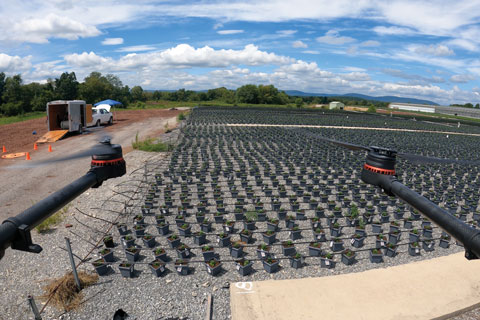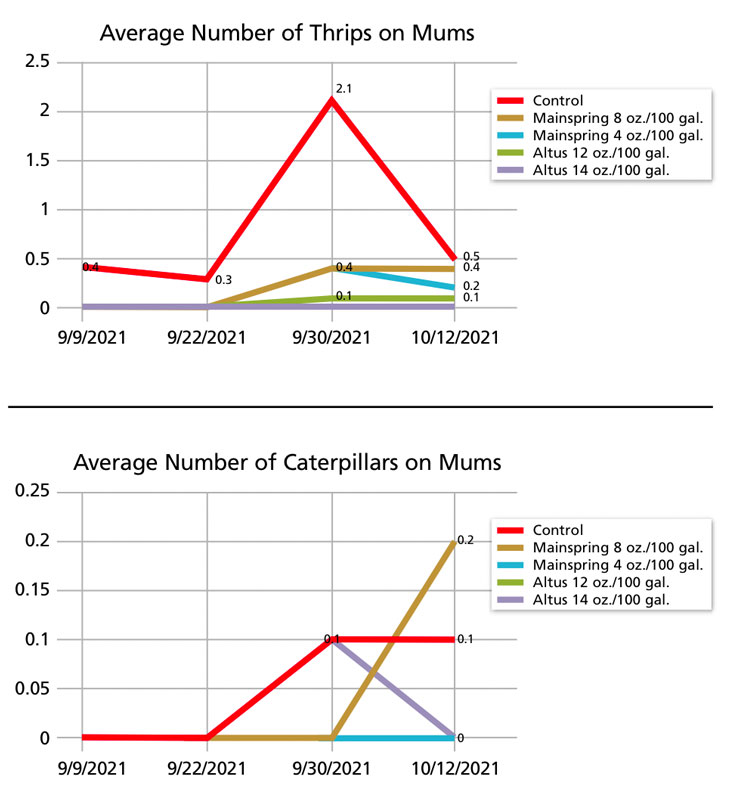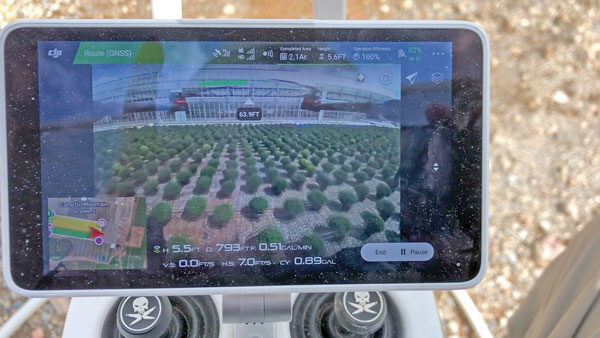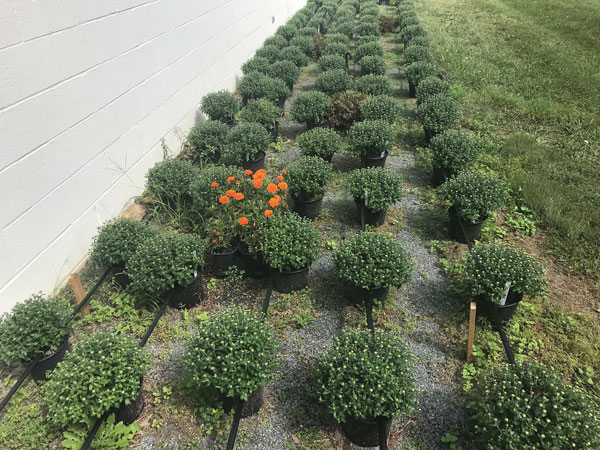2/1/2022
IPM From Above
Stanton Gill

For the last four years, the University of Maryland Extension IPM team has been working on how to effectively use drones in nurseries and greenhouses. Our IPM team is made up of myself, two University Extension plant pathologists—Karen Rane and David Clement—and University of Maryland Extension horticulturist Andrew Ristvey.
Pictured: A commercial greenhouse grower in Maryland agreed to participate in trialing pesticide applications using drones. Photo courtesy of Kirk Floyd.
We started using small drones with cameras mounted on them to see if we could use them for early detection of insect and disease problems. We’re still refining this important ongoing work. We’re moving on and working closely with a Maryland-based commercial drone applicator, Kirk Floyd of Kdrone Services LLC. Kirk obtained a drone capable of applying sprays onto horticultural crops. The drone is manufactured in China (as are 90% of the drones on the market) and the drone used in our trials is Model DJI Agras MG-1P.
Since we’ve worked closely with national chemical companies for years trialing new, low-risk pesticides for greenhouse crops and nursery plants, it was an easy leap into this application method. We contacted a couple of the national chemical companies (Syngenta and Bayer) to see if they were interested in trying out drone-applied applications of their low-risk pesticides on greenhouse and nursery crops. They were very supportive of this work.
 The Model DJI Agras MG-1P drone is outfitted with a 2.5-gallon spray tank. There are four spray nozzles and two 0.26 GPM pumps. It uses four TeeJet TX-VS8 nozzles. Kirk had to obtain approval from the Department of Homeland Security, the Federal Aviation Admin-istration, the state Department of Agriculture, and finally, find a willing insurance company. He made it through all of the hurdles.
The Model DJI Agras MG-1P drone is outfitted with a 2.5-gallon spray tank. There are four spray nozzles and two 0.26 GPM pumps. It uses four TeeJet TX-VS8 nozzles. Kirk had to obtain approval from the Department of Homeland Security, the Federal Aviation Admin-istration, the state Department of Agriculture, and finally, find a willing insurance company. He made it through all of the hurdles.
In the summer of 2021, we decided it was time to try this drone, equipped with sprayers, with a greenhouse crop—chrysanthemums. We worked with a large Maryland greenhouse operation that had 16 acres of chrysanthemum crops they grow outside their greenhouse structures. The plants were growing in either 8-in. or 14-in. diameter pots. All of the pots were trickle irrigated and grown on weed mat material overlaying a gravel base.
Situation
The major pests infesting chrysanthemums are western flower thrips, flower thrips, chrysanthemum aphid and several species of caterpillars, including salt marsh caterpillars, corn earworm, corn borer, woolybears, leafroller species and fall armyworms. They consume leaves, stems and flowers or terminal buds. Protecting mum crops from these major pests is high priority with many greenhouse growers.
Growers of large fields of chrysanthemums traditionally use a sprayer, dragging spray hoses through the crops, to treat mums for thrips, aphids and caterpillar control. Coverage is difficult to obtain and most growers use 100 gallons per acre. Multiple applications of insecticides (nine applications in previous years) are generally made to the crops from July through the end of September.
Trial #1
The commercial greenhouse we were working with sells to two major big box stores; the plants had to be perfect for this market. They were willing to work with us on this project, but all of the plants had to be treated and the backup was back to traditional spray methods if this drone application didn’t work.
We found western flower thrips and several species of caterpillars active in and near the production fields, so there was insect pressure present. It was decided that Mainspring from Syngenta would be the material we would evaluate at this working nursery.
Mainspring (Cyantraniliprole) is from Syngenta Crop Protection. The chemical component: -bromo-1-(3-chloro-2-pyridinyl)-N-[4-cyano-2-methyl-6-[(methylamino)carbonyl]phenyl]-1H-pyrazole-5-carboxamide. The price of Mainspring (price supplied by Nutrien Company) in the fall of 2021 was $334.75/pint.
 Pictured: A view of what drone operator Kirk Floyd sees as he navigated the drone over the mum crop. Photo courtesy of Kirk Floyd.
Pictured: A view of what drone operator Kirk Floyd sees as he navigated the drone over the mum crop. Photo courtesy of Kirk Floyd.
Drone application cost: Kdrone charges $150/hour, requiring one hour of set-up and take-down time (half hour for set up and half hour for take-down). Spraying time for 16 acres was three hours. A total of four hours at $150/hour for an application cost using a drone with sprayer was $600.
Application
Applications of Mainspring were made on August 20, 2021 at a rate of 6 oz. applied at 5 gallons per acre with the drone. A second application was made on September 11, 2021 at a rate of 4 oz. mixed in 5 gallons of water and applied for each acre of growing area. Sixteen total acres of mums were treated in all using 80 gallons of mixture to cover the 16 acres of mum crops.
In both cases in previous years, the growers had used 100 gallons per acre using a conventional hydraulic sprayer. Since the drone sprayer was very accurate in covering the plant material, we were able to obtain excellent coverage applying 5 gallons per acre.
Trial #2
The trial at the commercial greenhouse couldn’t have untreated control plants since they were selling plants into the marketplace and all plants had to be perfect at time of sale. We created a smaller replicate at the University of Maryland Central Maryland Research & Education Center using the same chrysanthemum cultivars growing in 8-in. diameter pots similar to the ones at the commercial greenhouse.
 In this second trial, we evaluated two rates of Mainspring and Altus (Bayer) with control plants. To increase the insect pressure, we brought in marigold and bacopa plants infested with western flower thrips and placed them among our plants after the chrysanthemum plants in the trial had been treated using the drone. Security lights near the plants served to increase moth activity at night to increase our chances moths would lay eggs on the plants.
In this second trial, we evaluated two rates of Mainspring and Altus (Bayer) with control plants. To increase the insect pressure, we brought in marigold and bacopa plants infested with western flower thrips and placed them among our plants after the chrysanthemum plants in the trial had been treated using the drone. Security lights near the plants served to increase moth activity at night to increase our chances moths would lay eggs on the plants.
Pictured: At the trial at the University of Maryland Central Maryland Research & Education Center, thrips-infested marigold plants were placed among the mums to increase the insect pressure. Photo courtesy of Stanton Gill.
These insecticides were applied in two passes over rows of chrysanthemums. The treatment rows were 100-ft. long and a 3-ft. wide swath was treated with each pass. We made two passes to increase the penetration of the spray. For the 8 oz./100-gallon rate, 0.01426 ml of Mainpsring was applied to the 300-sq. ft. area with 2 .5 liters of water. Water-sensitive spray cards were used to make sure coverage was thorough.
Treatments were applied on August 27, 2021 and insecticide efficacy was evaluated as percent mortality on multiple dates (one and two weeks after date of treatment, and continued at two-week intervals after this).
Impacts at the commercial greenhouse operation:
• Reduced the number of sprays from nine applications using standard spray equipment with hoses to two applications using the spray drone.
• Reduced the number of hours employees had to mix chemicals, put on protective equipment, work in the heat and drag hoses through crops.
• Control was rated excellent by the head grower and by the owner. They had a much happier work crew who didn’t have to drag hoses in the heat of summer.
• We greatly reduced the amount of water that served as the carrier for the insecticides to make the applications. Since the drone sprayer was very accurate in covering the plant material, we were able to obtain excellent coverage applying 5 gallons per acre.
CMREC trial results: A single application of either Mainspring or Altus kept the population of thrips and caterpillars below damaging levels through the length of the trial at CMREC.

The future
In 2022, we’ll expand our trials and test additional low-risk chemicals using drones. We’ll also evaluate and refine the use of drones to release predators and parasites over greenhouse crops.
This is part of our trials results. In part 2 next month, we’ll cover the use of spray drones in nursery field-grown plant material using several low-risk pesticides. GT
Hover over the QR code with your smart device camera to check out the pesticide drone in action.
Stanton Gill is an Extension Specialist in IPM and Entomology at the University of Maryland Extension, and the Central Maryland Research & Education Center. He can be reached at Sgill@umd.edu.